You can create processing features on basic objects, such as beams and plates.
The most important processing types are:
- Beam processing: trimming, coping, miter cuts, rectangular and circular contour cuts, or any type of contour.
- Plate processing: corner finishes, chamfers, outer plate contours and inner contours, etc.
The variety of processing options in Advance Steel allows you to create almost any beam and plate contour.
The tools for processing elements are grouped on the Features tool palette.
Processing object
Beams or plates are processed when you create a processing object. Processing features are displayed as green contours in the model. These features are Advance objects that cannot exist independently; they belong to a basic object (e.g. beam or plate). The object processing features are edited as individual objects. You can modify processing objects using grips.
Processing objects are created on the same layer as the associated basic object and can be deleted separately. If a basic element is deleted all processing objects will also be deleted.
Processing object representation
Processing objects do not have their own display type. Their representation is linked to the beams and plates representation. Processing objects are displayed in the model using the Features display type, set in the corresponding element properties dialog.
Rule-based processing
Some of the processing objects are based on rules (e.g. Element contour - rule, Cut at object). This means that when you modify a beam (e.g. a section) or a plate the processing is also modified.
As for joints, processings based on rules are controlled with a connection object, through which you can change feature properties.
The connection objects are represented in the model as gray objects (boxes).
You can display connection objects (boxes) by selecting one of the processing objects created by the joint and using the Display tool on the Joint Utilities panel of the Extended Modeling tab or by right clicking on the processing object and selecting Advance Joint Properties from the context menu.
The Feature representation style is required to display the connection object (box).
